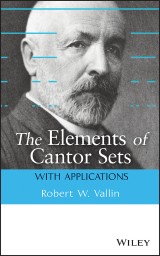Details

The Elements of Cantor Sets
With Applications1. Aufl.
|
84,99 € |
|
| Verlag: | Wiley |
| Format: | |
| Veröffentl.: | 30.07.2013 |
| ISBN/EAN: | 9781118548707 |
| Sprache: | englisch |
| Anzahl Seiten: | 256 |
DRM-geschütztes eBook, Sie benötigen z.B. Adobe Digital Editions und eine Adobe ID zum Lesen.
Beschreibungen
<p><b>A systematic and integrated approach to Cantor Sets and their applications to various branches of mathematics</b></p> <p><i>The Elements of Cantor Sets: With Applications</i> features a thorough introduction to Cantor Sets and applies these sets as a bridge between real analysis, probability, topology, and algebra.</p> <p>The author fills a gap in the current literature by providing an introductory and integrated perspective, thereby preparing readers for further study and building a deeper understanding of analysis, topology, set theory, number theory, and algebra.</p> <p><i>The Elements of Cantor Sets</i> provides coverage of:</p> <ul> <li>Basic definitions and background theorems as well as comprehensive mathematical details</li> <li>A biography of Georg Ferdinand Ludwig Philipp Cantor, one of the most significant mathematicians of the last century</li> <li>Chapter coverage of fractals and self-similar sets, sums of Cantor Sets, the role of Cantor Sets in creating pathological functions, <i>p</i>-adic numbers, and several generalizations of Cantor Sets</li> <li>A wide spectrum of topics from measure theory to the Monty Hall Problem</li> </ul> <p>An ideal text for courses in real analysis, topology, algebra, and set theory for undergraduate and graduate-level courses within mathematics, computer science, engineering, and physics departments, <i>The Elements of Cantor Sets</i> is also appropriate as a useful reference for researchers and secondary mathematics education majors. </p>
<p>Foreword xiii</p> <p>Preface xv</p> <p>Acknowledgments xvii</p> <p>Introduction xix</p> <p><b>1 A Quick Biography of Cantor 1</b></p> <p><b>2 Basics 5</b></p> <p>2.1 Review 5</p> <p>Exercises 14</p> <p><b>3 Introducing the Cantor Set 17</b></p> <p>3.1 Some Definitions and Basics 17</p> <p>3.2 Size of a Cantor Set 21</p> <p>3.3 Large and Small 46</p> <p>Exercises 48</p> <p><b>4 Cantor Sets and Continued Fractions 51</b></p> <p>4.1 Introducing Continued Fractions 52</p> <p>4.2 Constructing a Cantor Set 59</p> <p>4.3 Diophantine Equations 60</p> <p>4.4 Miscellaneous 63</p> <p>Exercises 65</p> <p><b>5 p-adic Numbers and Valuations 67</b></p> <p>5.1 Some Abstract Algebra 67</p> <p>5.2 p-adic Numbers 72</p> <p>5.3 p-adic Integers and Cantor Sets 80</p> <p>5.4 p-adic Rational Numbers 82</p> <p>Exercises 88</p> <p><b>6 Self-Similar Objects 91</b></p> <p>6.1 The Meaning of Self-Similar 91</p> <p>6.2 Metric Spaces 92</p> <p>6.3 Sequences in (<i>S; d</i>) 97</p> <p>6.4 Affine Transformations 106</p> <p>6.5 An Application for an IFS 112</p> <p>Exercises 115</p> <p><b>7 Various Notions of Dimension 117</b></p> <p>7.1 Limit Supremum and Limit Infimum 117</p> <p>7.2 Topological Dimension 121</p> <p>7.3 Similarity Dimension 125</p> <p>7.4 Box-Counting Dimension 126</p> <p>7.5 Hausdorff Measure and Dimension 129</p> <p>7.6 Miscellaneous Notions of Dimension 134</p> <p>Exercises 138</p> <p><b>8 Porosity and Thickness Looking</b></p> <p>at the Gaps 141</p> <p>8.1 The Porosity of a Set 141</p> <p>8.2 Symmetric Sets and Symmetric Porosity 144</p> <p>8.3 A New and Different Definition of Cantor Set 147</p> <p>8.4 Thickness of a Cantor Set 148</p> <p>8.5 Applying Thickness 149</p> <p>8.6 A Bit More on Thickness 151</p> <p>8.7 Porosity in a Metric Space 152</p> <p>Exercises 154</p> <p><b>9 Creating Pathological Functions via</b> C <b>155</b></p> <p>9.1 Sequences of Functions 155</p> <p>9.2 The Cantor Function 159</p> <p>9.3 Space-Filling Curves 165</p> <p>9.4 Baire Class One Functions 169</p> <p>9.5 Darboux Functions 171</p> <p>9.6 Linearly Continuous Functions 175</p> <p>Exercises 178</p> <p><b>10 Generalizations and Applications 179</b></p> <p>10.1 Generalizing Cantor Sets 179</p> <p>10.2 Fat Cantor Sets 183</p> <p>10.3 Sums of Cantor Sets 184</p> <p>10.4 Differences of Cantor Sets 191</p> <p>10.5 Products of Cantor Sets 193</p> <p>10.6 Cantor Target 195</p> <p>10.7 Ana Sets 196</p> <p>10.8 Average Distance 199</p> <p>10.9 Non-Averaging Sets 201</p> <p>10.10 Cantor Series and Cantor Sets 203</p> <p>10.11 Liouville Numbers and Irrationality Exponents 205</p> <p>10.12 Sets of Sums of Convergent Alternating Series 207</p> <p>10.13 The Monty Hall Problem 209</p> <p><b>11 Epilogue 215</b></p> <p>References 217</p>
<p>“This book could be used as a text for an undergraduate survey course of higher mathematics. It is an excellent reference for a graduate student, researcher or university instructor.” (<i>American Mathematical Society</i>, 1 March 2015)</p> <p>“Summing Up: Recommended. Upper-division undergraduates through researchers/faculty.” (<i>Choice</i>, 1 March 2014)</p> <p> </p>
<p><b>ROBERT W. VALLIN, PhD,</b> is Professor of Mathematics at Slippery Rock University. The recipient of numerous grants and awards, Dr. Vallin is also the author of over forty journal articles and has given many undergraduate and research talks on a variety of topics.</p>
<p><b>A systematic and integrated approach to Cantor Sets and their applications to various branches of mathematics</b></p> <p><i>The Elements of Cantor Sets: With Applications</i> features a thorough introduction to Cantor Sets and applies these sets as a bridge between real analysis, probability, topology, and algebra.</p> <p>The author fills a gap in the current literature by providing an introductory and integrated perspective, thereby preparing readers for further study and building a deeper understanding of analysis, topology, set theory, number theory, and algebra.</p> <p><i>The Elements of Cantor Sets</i> provides coverage of:</p> <ul> <li>Basic definitions and background theorems as well as comprehensive mathematical details</li> <li>A biography of Georg Ferdinand Ludwig Philipp Cantor, one of the most significant mathematicians of the last century</li> <li>Chapter coverage of fractals and self-similar sets, sums of Cantor Sets, the role of Cantor Sets in creating pathological functions, <i>p</i>-adic numbers, and several generalizations of Cantor Sets</li> <li>A wide spectrum of topics from measure theory to the Monty Hall Problem</li> </ul> <p>An ideal text for courses in real analysis, topology, algebra, and set theory for undergraduate and graduate-level courses within mathematics, computer science, engineering, and physics departments, <i>The Elements of Cantor Sets</i> is also appropriate as a useful reference for researchers and secondary mathematics education majors.</p>

















